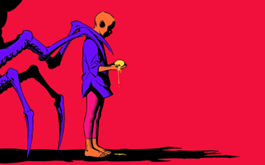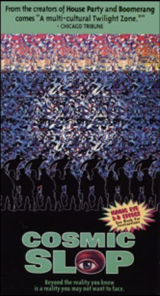The facts, alone, will not save us.
—Ruha Benjamin, ‘Racial Fictions, Biological Facts’ (2016: 2)
Anthropology, as a discipline, is deeply concerned with where it is going and how it can articulate its relevance to broader conversations. This includes discussion of decolonisation. While we embark on a journey to map formations and continuations of the structures in our world, and, retroactively, in our discipline, we have yet to outline or hypothesise concrete methods to undo these inequities. Here, I want to pull from conversations taking place amongst Black anthropologists, intellectuals, and other thinkers to hypothesise one way toward decolonisation through speculative methods.
Speculative methods, as discussed by Ruha Benjamin (2016), extend academic thought through experimentation in fictional storytelling. Benjamin writes, ‘Fictions, in this sense, are not falsehoods but refashionings through which analysts experiment with different scenarios, trajectories, and reversals, elaborating new values and testing different possibilities for creating more just and equitable societies. Such fictions are not meant to convince others of what is, but to expand our own visions of what is possible’ (2). Her essay uses an original fiction story, an account of the revival of Black victims of police brutality from the perspective of Aiyana Mo’Nay Stanley Jones, to consider the implications of her research on race, biological and stem cell research, the state, and citizenship. Her story outlines how state power perpetuates inequities by continuing to weaponise biological and stem cell research in acting upon Black bodies under the guise of inclusive, restorative practices. Within this study, Benjamin demonstrates inconsistencies in academic thought around biological research, Black citizenship, and the state as articulated in the events of the story. It also highlights potential places for further exploration of these relationships that also implicate shortcomings or limitations in our discipline.
An important aspect of Benjamin’s discussion revolves around the idea that anthropology is intimately connected to our conceptions of the future. Anthropologists work inductively and retroactively (based on the knowledge gleaned from being with and learning from our interlocutors in addition to employing reflexivity) to consider and expand our ideas about the relationships between cultures, abstract structures, ontologies, and epistemologies. We make arguments about how things were or are, but we leave discussions of how things might be or can be to realms of speculation. This suggests our discipline finds considerations of the future to be a tangential practice located away from pure, intellectual anthropological thought or a potentially dangerous practice due to its subjective nature. However, Benjamin’s practice illustrates one way of deepening anthropological thought requires us to partake in a reflexive practice—to use what we know was and is as starting points for what can be—that has the potential to underline what is missing within our research and how we construct our practices.
‘Place-making’ relies as much on multisensory, embodied knowledge and spatial knowledge as temporal knowledge (Feld & Basso 1996; Pink 2008). Determining anthropology’s place relies on sharing a sense of our past, present, and future. While many different words exist to describe this phenomenon, I will employ the term sankofa. Sankofa, a Ghanaian Akan Twi term, means ‘to go back and get it’ or ‘to retrieve’. It is usually employed in African diasporic communities as a call to know and reclaim our history in order to understand who we are and to learn from this past in order to envision and prepare for our futures. Alondra Nelson (2002) defines Afrofuturism and its practices as a manifestation of this endeavour (9-10), some of which are particularly interested in a future where ‘blacks free themselves from the constraints of racism’ (11).
Afrofuturist works employ sankofa (Samatar 2017) and imagination to ‘redefine culture and notions of Blackness’ while imagining Black people in the future (Womack 2013: 9), which serve as exercises of place-making for Black people through speculation and play.
W.E.B. DuBois’s ‘The Comet’ (1920) turns the world of the early 20th century on its head and, in doing so, temporarily suspends racial distinctions and Jim Crow-era laws that lead to segregation and marginalisation. He allows his Black and white protagonists to relate to each other only to reinstate those separations as a way to emphasise their arbitrariness in his contemporary society, long before social scientists took race as a construct to be true.

Octavia E. Butler’s story, ‘Bloodchild’ (1995), places Black people in an alien world where gendered assumptions of birth and surrogacy, regulation of bodies, conceptions of love, and coming-of-age processes are flipped while remaining eerily akin to the experiences of Black bodies in chattel slavery. The graphic nature of alien-human reproduction jerks the reader into reflection about the relationship between race and reproductive labour in our everyday lives and the degrees of relation that relationship has to relatively recent history.

Derrick Bell’s ‘The Space Traders’ (1992), which was later dramatised in the film Cosmic Slop (1994), sets forward a dilemma that questions the worth and value of Black people to non-Black communities in the face of opportunity to prosper. That these characters, even those advocating to save Black people, attempt to quantify or provide economic and social logics describing the value of Black people in the U.S. ultimately suggests how little Black lives are worth beyond functional utility to improve the outcomes of others.
All of these stories use speculative fiction to suggest the ‘place ‘of Black lives (with a myriad of conceptual and identity intersections) in U.S. society contemporary to their writing. They also create space to reflect on how Black people can expand or shift their orientation to place in order to expand or shift how they envision their futures.
Envisioning the futures implied by anthropological research and our discipline’s past only strengthens our awareness of what our discipline can be and where it can go. For example, Aimee Meredith Cox (2020) reminds us that addressing issues of diversity and decolonisation in anthropology begins with acknowledging the long history of Black anthropological thought—here, she asserts the significance of St Clair Drake’s essays (1978; 1980) in envisioning the histories and trajectories of Black scholarship in anthropology—and ethnographic practice that coexisted with the formation of the discipline in the 20th century. She argues, this forces us to consider the place of non-white, Western praxis and thought as foundational to our ‘field’ and potentially instructive of ways forward to decolonise our discipline. As another example, Smaran Dayal (2022) argues the use of ‘science fictionality’ is employed in narrative to ‘provide a necessary corrective to anthropology’s ethnographic realism, which too easily slips into modes and discourses of othering…’ (3). Employing speculative methods resists the impulse within anthropology to categorise or label concepts or people in our retellings of ethnographic fieldwork and subsequent research findings. It creates more space for people within our research works. These are two examples where engaging in the exercise of envisioning futures contributes to more effective place-making for anthropology.
We have also seen anthropologists engage in this exercise suggested by Benjamin. In ‘The Promises of Monsters’, Donna Haraway attempts to imagine an ‘absent, but perhaps possible, other present’ in our understandings of nature and social relations through consideration of stories (2011: 314). Likewise, Ruth Behar (1996) has drawn on her own creative writing in the form of poetry, fiction, memoir, filmmaking, etc. as examples with the capacity to expand our discipline’s capacity for reflexivity and consideration of our obligation to research interlocutors. Anthropologist Matthew Wolf-Meyer (2019) writes that ‘articulating futures—imagining them and bringing them into being—is an active process’ (14-15). What better way to consider the expansion of our discipline’s ideas actively than through exercises of storytelling based within the rich insights we have gleaned about people and cultures?
Below, I have written a short speculative piece to explore the connections between migration, racialisation, identity, hope, and agency. My hope is this creative engagement illustrates the capacity of speculative methods for expanding the possibilities of decolonising anthropological research in shifting the types of foci or questions we address in our research contexts:
*****
Viajar Dentro
The year is 2040. Espé finds herself on the other end of a perilous journey battered, bruised, and exhausted. She is with her kin and given a bed for the night. Yet, she cannot rest. Something is at work inside her, warring with her resolve.

Espé sat on the corner of the bed atop the shabby quilt that had seen many years and released a deep sigh. Every muscle in her body sang with fatigue and pain ushered in with the short, yet warm shower she took fifteen minutes prior. Her right hand worked a thick pink towel through her dark, wet shoulder length curls while her left hand kneaded an involuntary spasm in a sore thigh muscle. Her fragile, wide frame was draped in an oversized t-shirt and pajama pants borrowed from her aunt. Glancing around the small room, Espé noticed the blue wallpaper was yellowing in the corners and the furniture in the room, of which there was little, sat covered in a thin layer of dust. A single, burgundy armchair and chipped, mahogany side table with a small mirror faced the large bed upon which she rested. The sheer size of the bed, which could fit three or four people, only enhanced the narrowness of the room. Thankfully, the room was all hers for the night.
Rhythmically, she massaged the towel through her hair as her thoughts shifted to her father’s face the afternoon she fled from home. His gentle, dark eyes shone and he pursed his brown lips, his entire face contorted with something Espé could not identify. Finally, he softened, placed his hands on her shoulders, and kissed her forehead. Mi hija, he said, buen viaje. Espero que esto no te lleve. My daughter, safe journey. I hope it doesn’t take you.
There were stories, many stories, about the way journeying across the desert changes a person. They said something changed when the desert could no longer take them, when one no longer felt inexplicable heat weighing on the body or brushed sand from their eyes to keep going. That something else decided to take them, to even the score. That something would take you and you would never realise it until it presented itself to you. Like a mirrored-self smiling back at your frowning face, uncanny and evil. Espé had tried to push such stories out of mind as she donned a X43 desert suit, to regulate her body temperature, and adjusted the helmet to push air and water into her body properly. Yet, when she and five others stepped into the Mexican desert, she shivered involuntarily.
As her fingers gripped the towel, she remembered the sensation of grains of sand flowing through her fingers, coarse yet delicate and fluid as water. The crunch of the X43 suit material against sand gathering in the crevices between forearm and bicep, thigh and calf muscle. The sound of howling winds against her helmet. The wind whirling sand and debris passed her group onto jagged rocks at the edge of the border, seeming to place that additional weight upon the ground just for them. That weight was their only hope of making it beyond the sensors, designed to notify the authorities of unauthorised crossing, buried below. She recalled the feeling of elation and dread when she crossed those rocks with only a minor scrape, the reality and worry over her unwanted presence in this new land counteracted only by the determination to reach her kin, begin a new life.
After a moment, she realised her hands had slowed their work and begun to tremble. Squeezing the last moisture she could from her tight curls, she let the towel drop to her lap. A wave of overwhelm consumed her. Longing for her parents who still did not know she arrived and, given the tight surveillance of social media platforms, she could not inform them for a while. Contentment with warmth from the shower now settled into her bones. Gratitude for the distant aunt and uncle who ensured the home shared between migrants had space for her and sent her the funds to secure passage through a coyote with an X43 suit. Pain, aching within her, from the never-ending walk across the Sonoran desert, over the border, through the state of Arizona until she arrived in Cortez, Colorado. Pain from the stories she heard and the all-too-real horrors she witnessed in her journeying, which sat nestled in a pit below her ribcage. And, something else. This other feeling she could not name.
Espé stood to drape the wet towel over the dusty table and as she did her leg betrayed her. The spasm intensified in her thigh, causing her to trip and land on the floor. She winced knowing the knee she landed on would likely bruise overnight, flowering into a deliciously sickly blue against her brown skin. As she raised herself from the floor unsteadily, the sound of approaching footsteps disrupted the thick, night-time silence.
Are you okay? Her uncle on the other side of the door.
Sí. Espero no haberte despertado.
You didn’t. A pause. Esperanza, you should practice your English now. With us.
Espé felt a rush of annoyance and fear, the heat rising from the pit below her chest to her cheeks. Si, tío. I try tomorrow.
She picked up the towel as her uncle’s footsteps retreated and smoothed the towel on the table.
She glanced at herself in the mirror. It was not her. She was looking at something hollow, someone exhausted, a woman defeated. That is when Espé sees it.
A glint in the eye of her reflection. It is…knowing. Her reflection slowly begins to smile. That smile hangs on Espé’s own cheeks. The smile is not hers; it comes from the pit in her chest that animates her easily like a marionette. The longer the smile remains, the more it bores into her, until with a final tug at her cheekbones, the smile dissolves into resignation. Her gaze drops to the floor.
And then she cries.
Adaiah Hudgins-Lopez is a writer, dancer, creative, and PhD Social Anthropology student at the University of Cambridge. She is a 2021 and 2022 Gates Cambridge Scholar and member of Trinity College. Her writing and creative work centres Afrofuturist musings, narratives of migration, and explorations of community and movement building. She believes in the power of reciprocal storytelling to change the trajectory of how people relate to each other and the value of uplifting voices from the margins.
Bibliography
Behar, Ruth. 1996 [2022]. The Vulnerable Observer: Anthropology That Breaks Your Heart. Boston, MA: Beacon Press.
Bell, Derrick. 1992 [2000]. ‘The Space Traders’. In Dark Matter: A Century of Speculative Fiction from the African Diaspora, edited by Sheree Thomas. New York : Warner Books. 326-355.
Benjamin, Ruha. 2016. ‘Racial Fictions, Biological Facts’. Catalyst: Feminism, Theory, Technospace 2(2): 1-28.
Butler, Octavia E. 1996 [2005]. ‘Bloodchild’. In Bloodchild and Other Stories by Octavia E. Butler. New York, NY: Seven Stories Press. 1-29.
Cox, Aimee Meredith. 2020. ‘Can Anthropology Get Free?’ Transforming Anthropology 28(2): 118-120.
Dayal, Smaran. 2022. ‘Afterword: Anthropology and Science Fiction’. Anthropology and Humanism 0(0): 1-5.
DuBois, W.E.B. 1920 [2000]. ‘The Comet’. In Dark Matter: A Century of Speculative Fiction from the African Diaspora, edited by Sheree Thomas. New York : Warner Books. 5-18.
Feld, Steven and Keith Basso (eds). 1996. Senses of Place. Santa Fe, NM: School of Advanced Research Press.
Haraway, Donna. 2011. ‘The Promises of Monsters: A Regenerative Politics for Inappropriate/d Others’. In Cybersexualities: A Reader on Feminist Theory, Cyborgs and Cyberspace, edited by Jenny Wolmak. Edinburgh: Edinburgh University Press. 314-366.
Nelson, Alondra. 2002. ‘Introduction: Future Texts’. Social Text 20(2): 1-15.
Pink, Sarah. 2008. ‘An urban tour: The sensory sociality of ethnographic place-making’. In Ethnography 9(2): 175-196.
Samatar, Sofia. 2017. ‘Toward a Planetary History of Afrofuturism’. Research in African Literatures 48(4): 175-191.
St Clair Drake, John Gibbs. 1978. ‘Reflections on Anthropology and the Black Experience’. In Anthropology & Education Quarterly 9(2): 85-109.
———. 1980. ‘Anthropology and the Black Experience’. The Black Scholar 11(7): 2-31.
Wolf-Meyer, Matthew. 2019. Theory for the World to Come: Speculative Fiction and Apocalyptic Anthropology. Minneapolis, MN: University of Minnesota Press.Womack, Ytasha L. 2013. Afrofuturism: The World of Black Sci-Fi and Fantasy Culture. Chicago, IL: Chicago Review Press.
